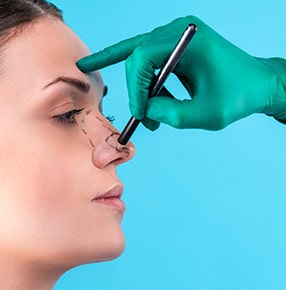
Secondary Rhinoplasty
A procedure that is considered as a supplementary procedure, it is performed if the patient did not get the desired appearance after the first operation. The main purpose of this operation is to correct the unfixed defects. This operation is done depending on the patient’s needs to correct the results of the first operation.

What Are The Conditions That Require Secondary Rhinoplasty?
This operation is performed if the patient faced one of these conditions after the first operation:
- If the nose holes were minimized too much which affects breathing.
- If a drop occurred in the nose.
- If the defects were not corrected as they should be, especially the nasal septum.
- If too much cartilage removed.
- If the nose tip was raised too much.
- If a droop occurred in the nose tip by time.
- If the nose is not symmetric with face’s elements.
- If the nose appeared unusual.
The most common conditions are the nose droop and tip droop.
We feel free to share some feedback from our honorable Patients

Garret D'silva,

Mary Fathima,

Helen Garcia,
Before Secondary Rhinoplasty
The patient should inform the doctor about their complaints and the unsatisfied results from the previous operation. The doctor should examine the patient’s nose in detail and determine the main problem. The nose should be examined with X-RAY to make sure there is no benign tumors, sinusitis, adenoids or nasal deflection, which affects breathing. Moreover, a blood test should be done to make sure there is no allergy to anesthesia. After the doctor’s examination and discussing the expectations, the operation is planned, the applied technique for eliminating the defects from the first operation should be determined.
The doctor may recommend some things before the operation such as:
- Stop using blood transfusions such as Aspirin for the prescribed period.
- Stop smoking before the operation.
- Do not consume foods or drinks for six hours before the operation.
If the defects to be fixed are simple, it is possible to perform the Secondary Rhinoplasty after six months of the first operation. If the defects needs a major surgery, the Secondary Rhinoplasty should be performed one or two years after the first one.
During Secondary Rhinoplasty
This operation is done under general anesthesia, unless the doctor recommends otherwise. It takes about 1-3 hours. It is possible to take about six hours depending on the operation size. The simple operations that corrects some millimeters can be done under local anesthesia and takes less time.
As with all nose surgeries, there are two types of surgery, open and close. In the Secondary Rhinoplasty, the open technique is much preferred. Since the change is major, it is possible to use the non-surgical solutions as a support for the Secondary Rhinoplasty.
If the nose is low due to the previous operation, the cartilage can be taken from behind the ears or the rib to eliminate this problem. There is no deformity in the area from which these cartilages are taken.
The Secondary Rhinoplasty is much more complicated than the regular rhinoplasty. The scars and wounds from the previous operation make this operation a bit harder. In addition to the aesthetic corrections, it is necessary to improve the breathing function. That is why an experienced doctor should do the operation.

After Secondary Rhinoplasty
After the operation, a plastic splint and bandage are placed on the nose. After one week, this splint and bandage are removed.
Depending on the operation size and the doctor’s opinion, the patient may leave the hospital after the operation, or may stay in the hospital for one day. The recovery period may be longer than the first operation, this varies from patient to another.
There are some points to consider after the operation such as:
- In the first week after the operation, keep your head straight even during sleep. This will help the patient to reduce swelling.
- At the end of the first week, bandages are removed and a supportive tape is placed for a week.
- If silicone is placed in the nose during the operation, it will be removed in the fourth week. In this period, avoid any shocks on the nose, you can shower after the doctor’s confirmation.
- Patients can go back to their daily life after one week of the operation.
- Patients can wear lenses after three days of the operation. It is possible to use glasses with light edges after one month and the heavy edges glasses after three months.
- After the operation, you can massage the nose with appropriate moves.
- It is possible to exercise light sports after two weeks of the operation, do not exercise heavy sports for the prescribed period by your doctor.
- Use the prescribed medications regularly.
The nose takes its new shape at the end of the third week, and the final shape after six months to one year.




